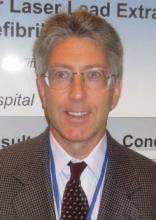VANCOUVER, B.C. – Laser lead extraction can damage nearby adjacent leads, and the damage isn’t always apparent at the time of removal, according to findings from a recent small study presented by Dr. Jeffrey Snow.
Sixteen patients underwent laser lead extraction at Winthrop University Hospital on Long Island (N.Y.) during defibrillator upgrades or replacement of recalled leads; 24 adjacent leads were left in place and reused. After a mean follow-up of 24 months, a reused lead failed in 4 of the 16 patients. Two patients had a loss of capture, one a fractured lead, and another a sensing noise artifact; the leads appeared to be working fine at the time of extraction.
Meanwhile, 40 control patients had new leads placed without laser extraction; 60 adjacent leads were left in place and reused. Not one failed during a mean follow-up of 25 months (P = .0099).
"In this study," leads remaining after laser extraction "were shown to have a decreased lifespan. If the finding is proved in a larger population, it would have a significant impact on our treatment strategy for recalled defibrillator leads," the authors concluded.
"This comes up most often in patients with a recalled lead. We have to figure out what to do about those leads; there isn’t a good answer out there in the literature," said lead investigator Dr. Snow, an electrophysiologist at Winthrop.
"You have the choice of trying to slip a new lead in alongside it, but that doesn’t always work. There may not be venous access. You could try to remove the lead that you worry may become defective and put a new lead in, which is what we were doing. It took us by surprise that by doing that, we were having a higher than expected failure rate in adjacent leads," he said at the 18th World Congress on Heart Disease.
"We act more quickly now to take out adjacent leads and just start fresh," especially if "it was a difficult extraction that took a lot of time and a lot of force or traction. We don’t want to find out in 6 months that [an adjacent] lead went bad and we have to operate for a third time," Dr. Snow said.
Dr. Snow said he has no relevant disclosures.


